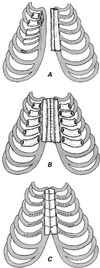Complete congenital sternal cleft associated with pectus excavatum
- PMID: 12224725
- PMCID: PMC124761
Complete congenital sternal cleft associated with pectus excavatum
Abstract
We report herein a rare case of complete congenital sternal cleft (absent sternum) and anterior pericardial defect in association with pectus excavatum. In neonates with absent sternum, the sternal bars can be easily approximated by simple suture, due to the flexibility of the cartilaginous thorax. There is also little danger of cardiac compression when the repair is performed early in life. If reconstruction is delayed, the increased rigidity of the chest wall and the physiologic accommodation of the thoracic organs to the circumference of the chest render simple approximation impossible, without serious compromise of the heart and lungs. Our patient was a 13-year-old girl, whose case was particularly unusual because of the association of sternal cleft with pectus excavatum. After surgical correction of the pectus excavatum, we were able to construct a sternum by incising the lateral border of each sternal bar, thereby creating flaps that we sutured together at midline. The sternal bars were then approximated by loops of nonabsorbable suture around their circumference. The patient had an uncomplicated course, and at the 12-month follow-up visit, her sternal appearance was normal.
Figures




References
-
- Shamberger RC, Welch KJ. Sternal defects. Pediatr Surg Int 1990;5:156–64.
-
- Suri RK, Sharma RK, Jha NK, Sharma BK. Complete congenital sternal cleft in an adult: repair by autogenous tissues. Ann Thorac Surg 1996;62:573–5. - PubMed
-
- Ravitch MM. Disorders of the sternum and the thoracic wall. In: Sabiston DC Jr, Spencer FC, editors. Gibbon's surgery of the chest. 4th ed. Philadelphia: WB Saunders; 1983. p. 318–60.
-
- de Campos JR, Filomeno LT, Fernandez A, Ruiz RL, Minamoto H, Werebe Ede C, Jatene FB. Repair of congenital sternal cleft in infants and adolescents. Ann Thorac Surg 1998;66:1151–4. - PubMed
-
- Samarrai AA, Charmockly HA, Attra AA. Complete cleft sternum: classification and surgical repair. Int Surg 1985;70:71–3. - PubMed
Publication types
MeSH terms
LinkOut - more resources
Full Text Sources
Medical
